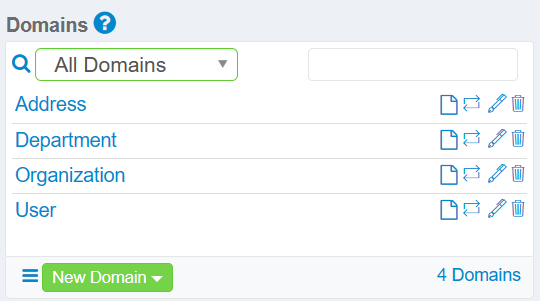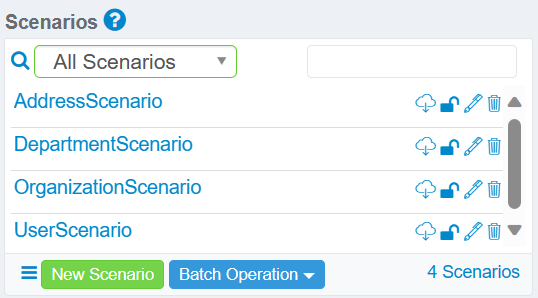Description
Users will see the Project Dashboard when logging into the GenRocket web platform. This dashboard may be used to view, create, and manage the following:
- Projects
- Organization Resources
- Project Versions
- Domains
- Scenarios
- Scenario Chains
- Scenario Chain Sets

In This Article
- Common Project Dashboard Icons
- Projects Pane
- Queue Status Pane
- Resources Pane
- Project Versions Pane
- Domains Pane
- Scenarios Pane
- Scenario Chains Pane
- Scenario Chain Sets Pane
- Management Pane
Common Project Dashboard Icons
The following icons are commonly used in the Project Dashboard:
| Icon | Description |
 | The item is currently unlocked. Click to lock a Project, Project Version, or Scenario. Locks are provided at each level within the GenRocket platform to prevent changes occurring at the Template level from cascading down to other levels, such as the Scenario level. When an item is locked, it cannot be deleted. |
 | The item is currently locked. Click to unlock a Project, Project Version, or Scenario. |
 | Edit a Project, Project Version, Domain, Scenario, Resource Values, etc. For example, change the Project name and description. |
 | View references for an item (e.g., Organization Resources, Domains, etc.). |
 | Remove a Project, Project Version, Domain, Scenario, etc. |
 | View more information about an item in the dashboard. |
Projects Pane
The Projects Pane can be used to view and manage all Projects within an Organization. Projects can be filtered by the owner by using the drop-down at the bottom of the pane.

| Option | Description |
 | Create a new Test Data Project. For more information, click here. |
 | Filter existing Test Data Projects by users within the organization. Users can filter projects shown in the Projects Pane using the Project Filter. Projects may be filtered by:
|
 | Open the Browse Projects dialog window. This window can be used to view a full list of Projects and browse by keyword. |
 | View the teams you are part of. If you do not belong to any teams, no teams will be displayed. |
 | Assign Categories and Tags to Projects. To learn more about Project Categorization, click here. |
 | Create a Project Preset using the Project's configuration. For more information on creating a Project Preset, click here. |
Queue Status Pane
The Queue Status Pane shows any tasks in the queue waiting to be processed.
Resources Pane
Organization Admins can use the Resources Pane within the Project Dashboard to add and manage Organization Resources. Resource values may be configured by all users and are used for test data generation. 
| Option | Description |
 | Add an Organization Resource. These resources are seen by all users; however, users who are not Organization Admins can only edit the Resource's value. |
 | The Download drop-down menu can be used to download the logged in user's profile, a Server, or an offline certificate. |
 | Select and view Server Resources. Organization Admins can add one or more Server Resources from the My Organization page. For more information on how to add a Server Resource, click here. |
Project Versions Pane
A Project can have one or many versions. Each version has its own Domains, Receivers, and Scenarios.
The Project Versions Pane can be used to view and manage each version of a given Project separately within the web platform.

| Option | Description |
 | Create a New Project Version or Copy a Project Version |
 | Use Generator Search to find Generators currently assigned to Domain Attributes within the selected Project Version. Click here for more information. |
 | Access and manage Master Projects for a given Project Version. For more information, click here. |
 | View XTS Import Audit Reports for a given Project Version. To learn more about XTS import, click here. |
 | Access the Domain Referencing Wizard for a given Project Version. This feature can be used to validate and set up Parent-Child-Sibling Relationships when importing your data model into a Test Data Project. For more information, click here. |
 | View the Project Version Status Report for a Project Version. This report shows the following information:
|
 | The Global Seed Assigner icon can be used to assign the Global Seed value to each Domain that has a seed value within the Project Version. |
 | The View Resource Change icon will be available when a Project (Version) has been copied from one Organization (e.g., A1) to another Organization (e.g., A2) and one or more resources in Organization A1 do not exist in Organization A2. This icon can be used to view all the places where users in Organization A2 need to update the Resource(s). |
 | Access the Generator Tuning Wizard to view all Generators for the Project Version and make modifications. For more information, click here. |
 | The Self Serve Menu Options drop-down menu can be used to access Self Service Platform features (G-Cases, G-Rules, G-Queries, G-Stories, G-Epics, G-Subset, G-Families, and G-Questionnaire. |
Domains Pane
The Domains Pane can be used to view and manage all Domains for a selected Project Version within a given Project.
Click on a Domain Name to view and manage its Attributes, Global Variables, Receivers, Scenarios, and Parent-Child-Sibling Relationships.

| Options | Description |
 | The New Domain drop-down menu can be used to:
Note: To learn more about each of the options in this menu, click here. |
 | Filter Domains by category. Click here to learn how to create Domain Categories. |
 | Open the Advanced Domain Search dialog. |
 | Expand the Domains Pane to full screen. |
 | View the Domain Report, which shows each Attribute, assigned Generators, and their configured parameters for the selected Domain. |
Scenarios Pane
The Scenarios Pane can be used to view and manage Scenarios for a selected Project Version. Click on a Scenario to view its details in the Scenario Dashboard.

| Option | Description |
 | Filter Scenarios within the Scenarios Pane by Category. Categories are used to organize specific components within the web platform (e.g., Domains, Scenarios, Scenario Chains, and Scenario Chain Sets). Scenario Categories can be created from the Scenario Dashboard. |
 | Create a new Scenario for a single Domain. |
 | This menu has multiple options: |
 | Open the Advanced Scenario Search dialog. |
 | Expand the Scenarios Pane to full screen. |
Scenario Chains Pane
The Scenario Chains Pane can be used to view and manage Scenario Chains for a selected Project Version.
Select a Scenario Chain within the Scenario Chains Pane to view its configuration details within the Scenario Chain Dashboard. To learn more about Scenario Chains, click here.

| Option | Description |
 | Filter Scenario Chains by Category within the Scenario Chains Pane. Categories are used to organize specific components within the web platform (e.g., Domains, Scenarios, Scenario Chains, and Scenario Chain Sets). Scenario Chain Categories can be created from the Scenario Chain Dashboard. |
 | Create a new Scenario Chain. Click here for more information. |
 | Open the Advanced Scenario Chain Search dialog. |
 | Expand the Scenario Chains Pane to full screen. |
Scenario Chain Sets Pane
The Scenario Chain Sets Pane can be used to view and manage Scenario Chain Sets for a selected Project Version.
Select a Scenario Chain Set within the Scenario Chain Sets Pane to view its configuration details within the Scenario Chain Set Dashboard.

| Options | Description |
 | Filter Scenario Chain Sets by Category within the Scenario Chain Sets Pane. Categories are used to organize specific components within the web platform (e.g., Domains, Scenarios, Scenario Chains, and Scenario Chain Sets). Scenario Chain Set Categories can be created from the Scenario Chain Set Dashboard. |
 | Create a new Scenario Chain Set. Click here for more information. |
 | Open the Advanced Scenario Chain Set Search dialog. |
Management Pane
The Management Pane contains four tabs which can be used to manage the following:
| Tab | Description |
| Project Version Variable | View, create, and manage Project Version Variable Sets. |
| Configuration Management | Create one or more configuration files, which are required to merge data from different Domains (in Segment format) into one or more files. For example, a configuration file can be used to create nested:
|
| Migration Management | Create a migration configuration file used by the G-Migration feature to migrate small or large amounts of data from a source database to a destination database for one or many tables. |
| Generator Tags | View, create, and manage Project Level Generator Tags. Generator Tags allow you to automatically assign a Generator to an attribute intelligently. |


